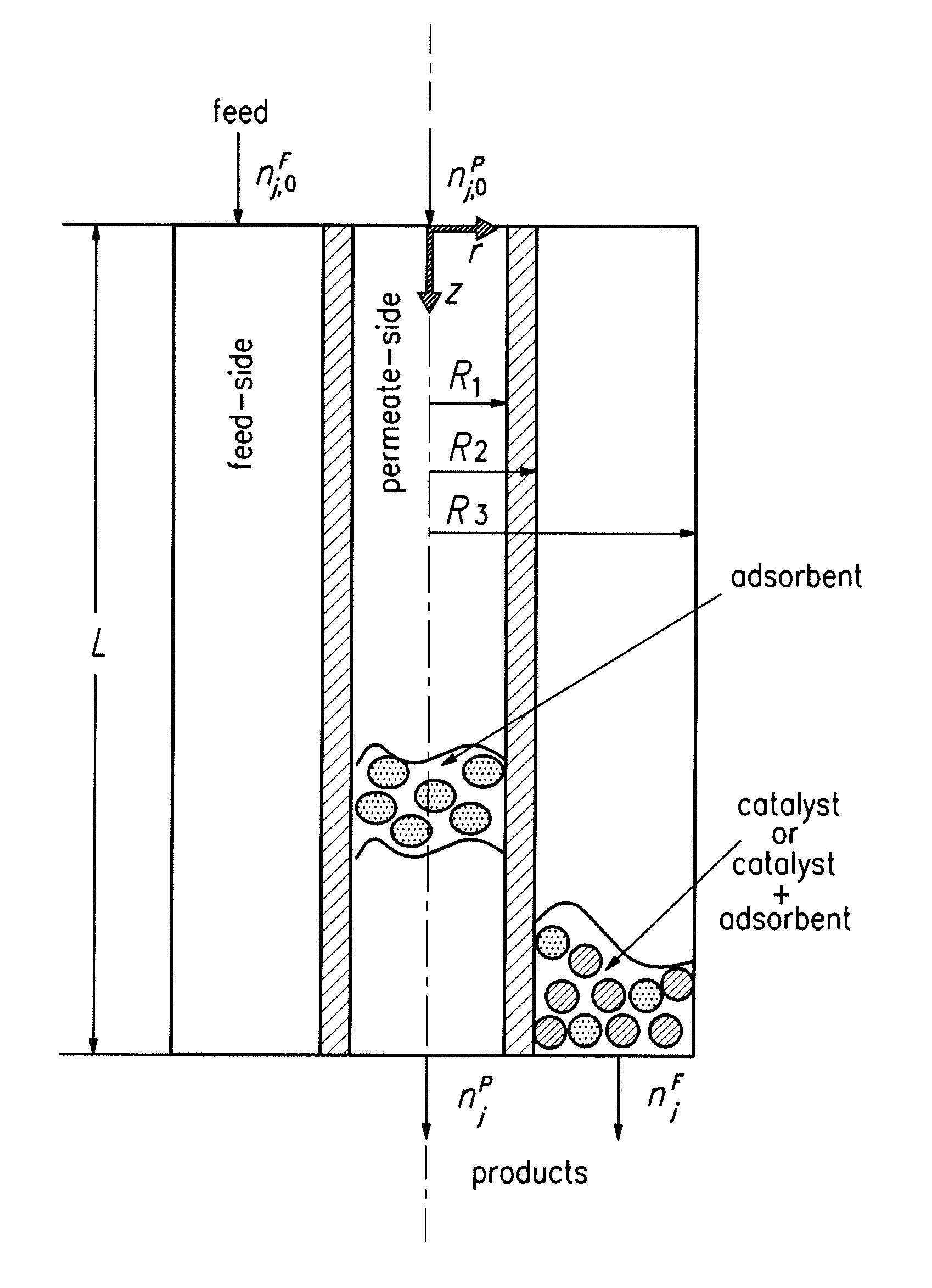Hybrid adsorptive membrane reactor
a membrane reactor and hybrid technology, applied in the field of chemical reactors, can solve the problems of difficult manufacturing, high cost of metallic membranes, difficult to manufacture, and often neither convenient nor economical for small-scale production, and achieve the effect of improving product yield and purity
- Summary
- Abstract
- Description
- Claims
- Application Information
AI Technical Summary
Benefits of technology
Problems solved by technology
Method used
Image
Examples
example i
CO2 Selective Ceramic Membrane for Water-Gas-Shift Reaction with Concomitant Recovery of CO2
[0101] Two process schemes were investigated for the use of hydrotalcites as CO2 adsorbents to enhance WGS reaction: Case I involved the adsorption-enhanced WGS packed bed reactor (AR) and Case II involved the adsorption-enhanced WGS membrane reactor (HAMR). They are presented here along with Base Case (WGS Packed Bed Reactor in conjunction with CO2 removal via pressure swing adsorption (PSA)). Both cases were to improve the WGS reactor efficiency via the concomitant removal of CO2 for sequestration. The AR system has been discussed in the literature (see, e.g., Waldron et al. (2001) AIChE J. 47:1477 and Hufton et al. (1999) AIChE J. 45:248). The HAMR system included a packed bed catalytic membrane reactor (hydrogen selective) coupling the WGS reaction (in a porous hydrogen selective membrane) with CO2 removal with an adsorbent in the permeate side. The reactor characteristics were investiga...
example ii
A High Efficiency, Low Temperature Reformer for Hydrogen Production
Description of the Technology
[0145] The technology involves the use of a high-efficiency, low-temperature reactor for steam reforming. With this reactor system, H2 production can be operated at 350 to 400° C., as opposed to >800° C. The essence of the process is the employment of a unique membrane- and adsorption-enhanced reformer, which can preferentially allow H2 permeation and CO2 adsorption simultaneously, the two ultimate reaction products from steam reforming. Thus, the reformer can produce a H2 product continuously until the adsorbent is saturated for regeneration via PSA. This unique reactor configuration can be viewed as a simplified MR under PSA operation, suitable for a scaled-down version of the steam reforming process. MR technology and sorption-enhanced PSA proposed in the literature allow only one of the reaction products, such as H2 or CO2, to be removed; the reaction rate enhancement that results ...
example iii
A High Efficiency, Low Temperature Reformer for Hydrogen Production
Introduction
[0159] A novel reactor system, termed HAMR, was investigated. The HAMR concept couples the reaction and membrane separation steps with adsorption on the reactor and / or membrane permeate side (Park (2001) Models and Experiments with Pervaporation Membrane Reactors Integrated with a Water Removal Adsorbent System, Ph.D. Thesis, University of Southern California, Los Angeles, Calif., Park and Tsotsis (2004) System. Chem. Eng. Proc. 43:1171, and Park (2004) Korean J. Chem. Eng. 21:782). The HAMR system investigated previously involved a hybrid pervaporation MR system and integrated the reaction and pervaporation steps through a membrane with water adsorption. Coupling reaction, pervaporation, and adsorption significantly improved the performance. Most recently, Elnashaie and co-workers (Chen and Elnashaie (2004) Ind. Eng. Chem. Res. 43:5449, Prasad and Elnashaie (2004) Ind. Eng. Chem. Res. 43:494, Prasad a...
PUM
| Property | Measurement | Unit |
|---|---|---|
| pressures | aaaaa | aaaaa |
| temperatures | aaaaa | aaaaa |
| temperatures | aaaaa | aaaaa |
Abstract
Description
Claims
Application Information
 Login to View More
Login to View More - R&D
- Intellectual Property
- Life Sciences
- Materials
- Tech Scout
- Unparalleled Data Quality
- Higher Quality Content
- 60% Fewer Hallucinations
Browse by: Latest US Patents, China's latest patents, Technical Efficacy Thesaurus, Application Domain, Technology Topic, Popular Technical Reports.
© 2025 PatSnap. All rights reserved.Legal|Privacy policy|Modern Slavery Act Transparency Statement|Sitemap|About US| Contact US: help@patsnap.com



